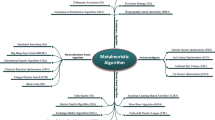Abstract
The aim of this study is to present a new efficient optimization algorithm called Teaching-Learning-Based Optimization (TLBO). The TLBO algorithm is based on the effect of the influence of a teacher on the output of learners in a class. Several benchmark problem related truss structures with discrete design variables are used to show the efficiency of the TLBO algorithm and the results are compared with those reported in the literature. It is concluded that the TLBO algorithm presented in this study can be effectively used in the weight minimization of truss structures.
Similar content being viewed by others
References
Camp, C. V. and Bichon, B. J. (2004). “Design of space trusses using ant colony optimization.” Journal of Structural Engineering, Vol. 130, No. 7, pp. 741–751.
Capriles, P. V. S. Z., Fonseca, L. G., Barbosa, H. J. C., and Lemonge, A. C. C. (2007). “Rank-based ant colony algorithms for truss weight minimization with discrete variables.” Communications in Numerical Methods in Engineering, Vol. 23, pp. 553–575.
Cerny, V. (1985). “Thermodynamical approach to the travelling saleman problem: An efficient simulation algorithm.” J. Optim. Theory Appl., Vol. 45, pp. 41–51.
Dorigo, M. (1991). Ant colony optimization, new optimization techniques in engineering, by Onwubolu, G. C., and Babu B. V., Springer-Verlag Berlin Heidelberg, pp. 101–117.
Eskandar, H., Salehi, P., and Sabour, M. H. (2011). “Imperialist competitive ant colony algorithm for truss structures.” World Applied Sciences Journal, Vol. 12, No. 1, pp. 105–2011
Geem, Z. W., Kim, J. H., and Loganathan, G. V. (2001). “A new heuristic optimization algorithm: Harmony search.” Simulation, Vol. 76, No. 2, pp. 60–8.
Ghasemi, M. R., Hinton, E., and Wood, R. D. (1997). “Optimization of trusses using genetic algorithms for discrete and continuous variables.” Engineering Computations, Vol. 16, pp. 272–301.
Goldberg, D. E. (1989). Genetic algorithms in search, Optimization and Machine Learning, New York.
Holland, J. H. (1975). Adaptation in natural and artificial systems, The University of Michigan Press, Ann Arbor, Mich.
Kaveh, A. and Abadi, A. S. M. (2011). “Harmony search based algorithms for the optimum cost design of reinforced concerete cantilever retaining walls.” International Journal of Civil Engineering, Vol. 9, No. 1, pp. 1–8.
Kaveh, A. and Talatahari, S. (2009). “A particle swarm ant colony optimization for truss structures with discrete variables.” Journal of Constructional Steel Res., Vol. 65, pp. 1558–1568.
Kennedy, J. and Eberhart, R. (1995). “Particle swarm optimization.” In: Proc. 1995 IEEE Int. Conf. Neural Networks, Piscataway: IEEE Service Center, Vol. 4 (held in Perth), pp. 1942–1948.
Kirkpatrick, S., Gelatt, C. D., and Vecchi, M. P. (1983). “Optimization by simulated annealing.” Science, Vol. 220, No. 4598, pp.671–80.
Lee, K. S., Geem, Z. W., Lee, S. H., and Bae, K. W. (2005). “The harmony search heuristic algorithm for discrete structural optimization.” Engineering Optimization, Vol. 37, No. 7, pp. 663–684.
Lemonge, A. C. C. and Barbosa, H. J. C. (2004). “An adaptive penalty scheme for genetic algorithms in structural optimization.” International Journal for Numerical Methods in Engineering, Vol. 59, pp. 703–736.
Li, L. J., Huang, Z. B., and Liu, F. A. (2009). “A meta heuristic particle swarm optimization method for truss structures with discrete variables.” Computer and Structures, Vol. 87, pp. 435–443.
Rajeev, S. and Krishnamoorthy, C. S. (1992). “Discrete optimization of structures using genetic algorithm.” J. Struct. Eng., Vol. 118, No. 5, pp. 1233–250.
Rao, R. V., Savsani, V. J., and Vakharia, D. P. (2011). “Teaching-learningbased optimization: A novel method for constrained mechanical design optimization problems.” Computer-Aided Design, Vol. 4, pp. 303–315.
Sönmez, M. (2011). “Discrete optimum design of truss structures using artificial bee colony algorithm.” Struct. Multidisc Optim., Vol. 43, pp. 85–97.
Wu, S. J. and Chow, P. T. (1995). “Steady-state genetic algorithm for discrete optimization of trusses.” Computer and Structures, Vol. 56, No. 6, pp. 979–991.
Zhang, Y. N., Liu, J. P., Liu, B., Zhu, C. Y., and Li, Y. (2003). “Application of improved hybrid genetic algorithm to optimize.” J South China Univ. Technol., Vol. 33, No. 3, pp. 69–72.
Author information
Authors and Affiliations
Corresponding author
Rights and permissions
About this article
Cite this article
Dede, T. Application of Teaching-Learning-Based-Optimization algorithm for the discrete optimization of truss structures. KSCE J Civ Eng 18, 1759–1767 (2014). https://doi.org/10.1007/s12205-014-0553-8
Received:
Accepted:
Published:
Issue Date:
DOI: https://doi.org/10.1007/s12205-014-0553-8




